
Fredericqia chiton
Flat Forked Seaweed, Thin Forked Seaweed
4 July 2023
Point Holmes, Strait of Georgia, B.C., Canada
Tide: minus 0.2 feet at 1:06 pm PDT (measured at Little River Tidal Station)
Weather: Hazy, partly high overcast 10% increasing to 50%, wind NE 10 – 20 km/hour, sea rippled, humidity 60%, 21˚C.
Moon: Waning Gibbous (97.4%); Previous Phase, Full Moon, 3 July 2023 at 4:38am PDT; Next Phase, Third Quarter, 9 July 2023 at 6:47pm PDT.
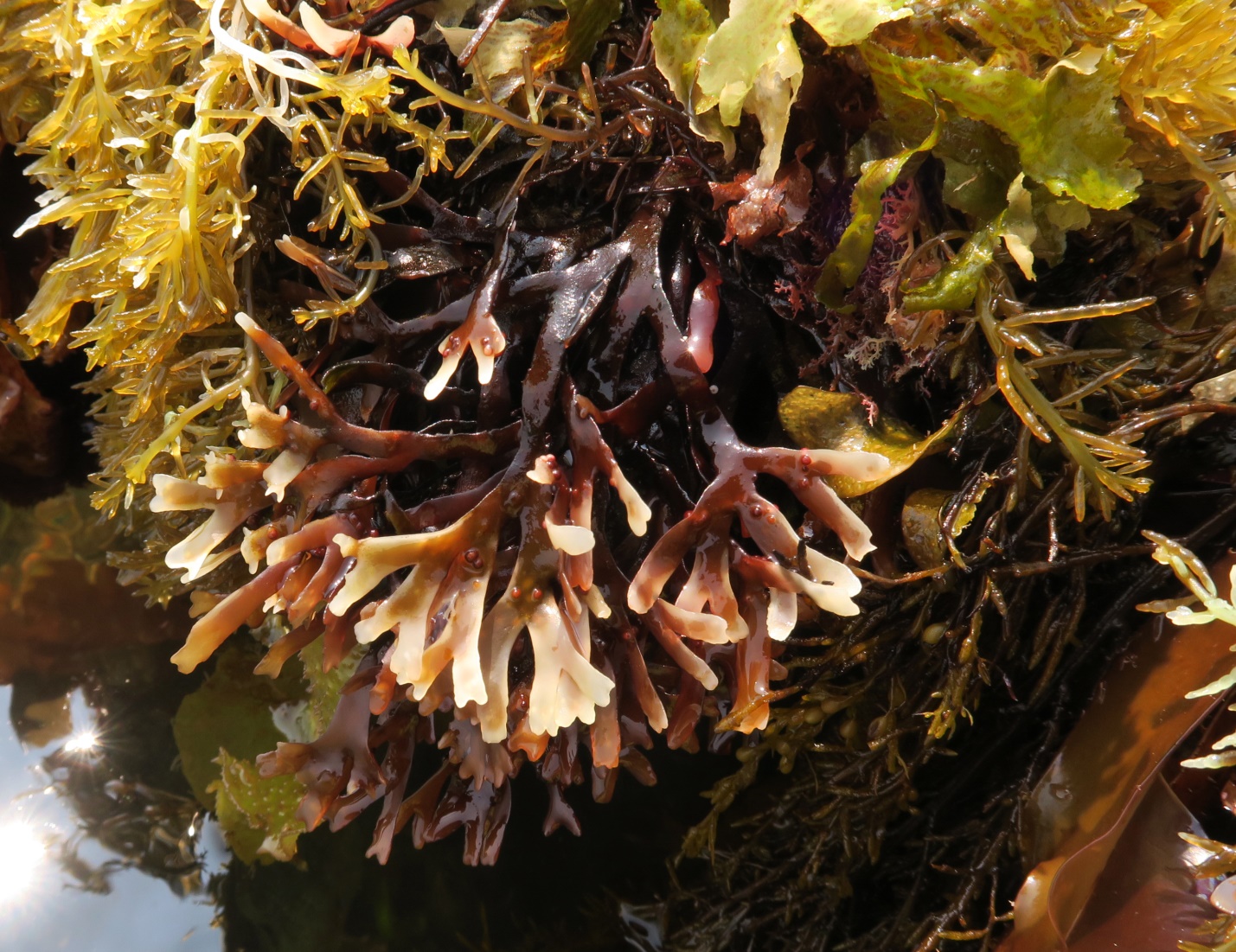
Figure 1: Here the thin and flattened thalli of Fredericqia chiton are revealed after lifting away a few blades of other seaweeds that were covering and shading it. Despite the shading, Fredericqia chiton is showing strong sun-bleaching as its forked tips have faded from red to green, and then from green to nearly white. On the surface of the thalli you can also see round protrusions, they’re quite large and conspicuous and are the reproductive parts of these red algae. Point Holmes, Strait of Georgia, B.C., Canada. July 4, 2023. Photo ID 27571 ©Seaweedwhisperings.com
Person 1:
Stiff, flattened forks.
Smooth to touch.
Reddish at base, greener towards tips.
As with many other seaweeds here today, most specimens are bleached, at least at the tips.
Moves rigidly in the water.
Forks are like antennae, reaching out and listening.
Quite content, things are just fine the way they are.
Clumps of F.C. are growing where they could be overwhelmed by the blades of adjacent Chondracanthus. However, F.C. is confident in its place, not worried about being pushed out.
Very firmly attached to the rock substrate. Will not be dislodged!
Will not be broken!
Determined.
Grows in small clumps.
Much more orderly in appearance than the other seaweeds here.
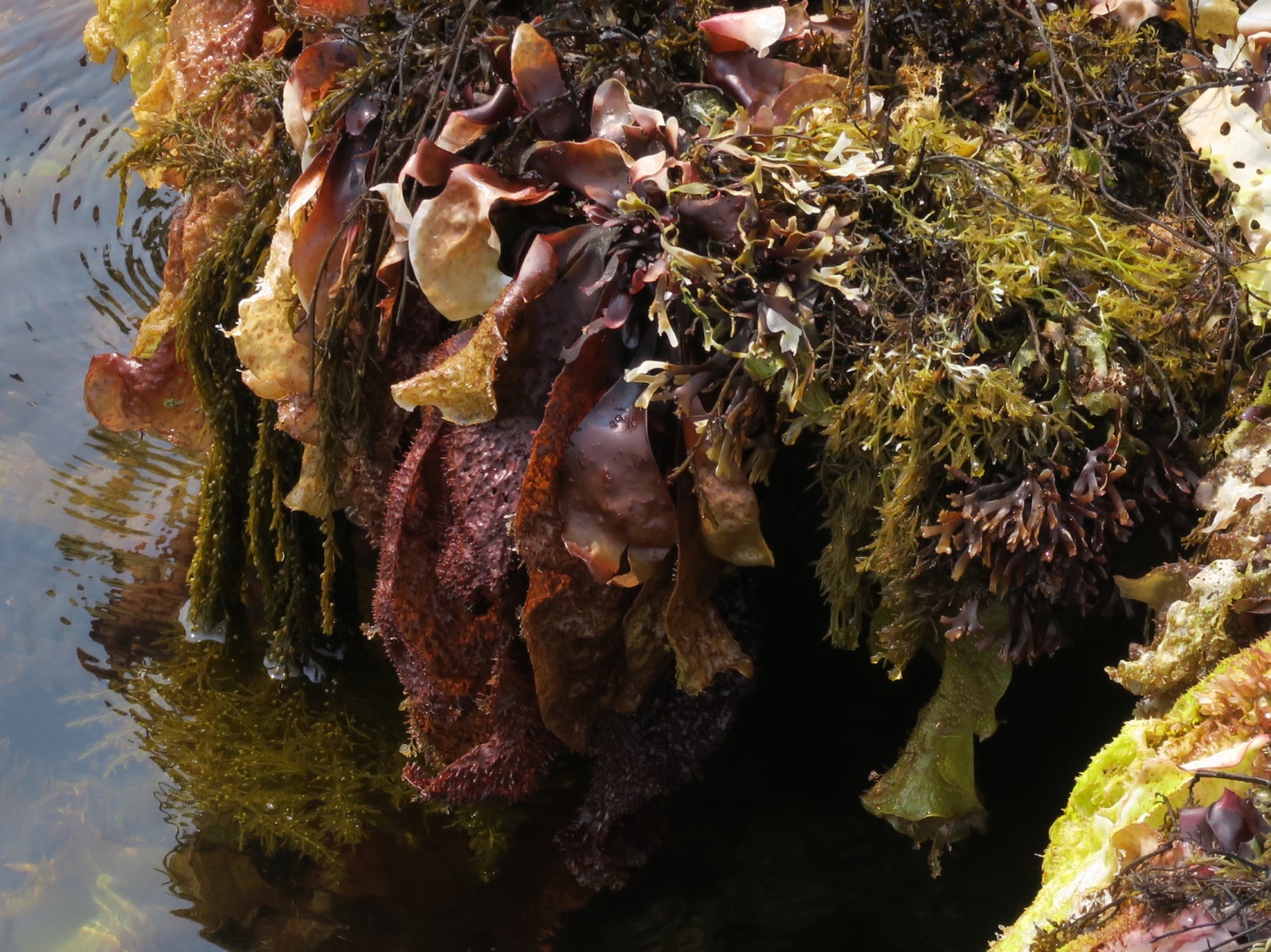
Figure 2: Point Holmes has some rock outcroppings that are situated adjacent to both gravel and sandy beaches. These rocks are conglomerate and craggy and pitted with holes, and on their edges a plethora of seaweeds make their home. Cascading over and from the lip and vertical surfaces of the rock at this season, a colorful array of red and brown algae predominates. The reds are bleaching in the long summer days and in this colorful mix it could be easy to overlook Fredericqia chiton – especially as it takes kindly to being shaded by other seaweeds as protection from over exposure to sun and air at low tide. Two clusters of Flat Forked Seaweed are visible here; one is atop and close to the center of the rock ledge, and the second is reaching down to the sea on the far right near the cleft in the rock. The lower individual is closer to healthy “red” in coloration and the higher one has many of its “forks” bleached to white. Point Holmes, Strait of Georgia, B.C., Canada. July 4, 2023. Photo ID 27572 ©Seaweedwhisperings.com
Person 2:
I wanted to sit on the edge of the rock outcropping here exactly so that I could see one individual of this species – and I quickly realized I was doing as Fredericqia does. I have my feet dangling in the cool ocean just how this seaweed hangs onto rock edges and drapes down into the ocean waters.
On this very low tide day much of the F. chiton we found is already bleaching from its healthy dark wine-red color to yellow-greenish and even white at its tips. The base of the thallus is still red and this confirms it as a member of the subset of seaweeds known as the “red” alga.
The thallus is thin and somewhat stiff, and very flattened.
It forks dichotomously, in clearly patterned V’s; it forks and forks strongly again at least three times. There is no diminishment in the ‘firmness’ of this alga along the thallus; it is uniformly strong.
Very much reminiscent of Ahnfeltiopsis linearis, another ‘Forked Seaweed’ but this seaweed wants to be anchored on rock and doesn’t seem to want to, nor seem to tolerate, being buried in sand or fine gravel (like A. linearis does).
Is that typical for Fredericqia chiton and therefore distinguishing?
Since we’ve never before found this “uncommon” alga in the last three and one half years of exploring, perhaps it is typical and indicative of the habitat preference for this particular species.
Possibly it has a very narrow niche? Maybe it requires a zone comfortable for life that is really not very easy to find in most locations?
Today in the hot sun, high temperature, and midday full exposure I am finding these conditions are marginal for my comfort, and that is with knowing I’ll be able to retreat to some shade when I choose to. Fredericqia chiton seems to find its shade under the adjacent very broad and leafy blades of Chondracanthus exasperatus.
As a true “red”, I think this seaweed does better deeper (more deeply immersed) or in lower light.
It has a very firm texture.
Its shape and form is pretty consistent – seems fixed in its design.
Is this seaweed very certain of what works for it? Is it done with any testing out or experimenting with the “new”?
It feels like that is true.
The individual that I’ve been observing is now exposed above the waterline (as the tide has gently receded) and it is sitting upright; it is rather erect and is NOT lying limply on the rocks and neighboring seaweeds like many other algae are doing here in these same conditions.
Can you not really ever relax Fredericqia chiton?
Or is being stiff, erect, upright and fixed so comfortable to you, so normal and ‘right’ for you, that, in fact, this is exactly how you best can “do” relaxed? That possibly stiff-erect-firm-upright is the only mode that is truly comfortable and easy for you...?

Figure 3: A closer view of our species of interest, Fredericqia chiton. The deep wine red coloration is fading here at peak summer, and this individual is successfully producing reproductive cells. Point Holmes, Strait of Georgia, B.C., Canada. July 4, 2023. Photo ID 27573 ©Seaweedwhisperings.com
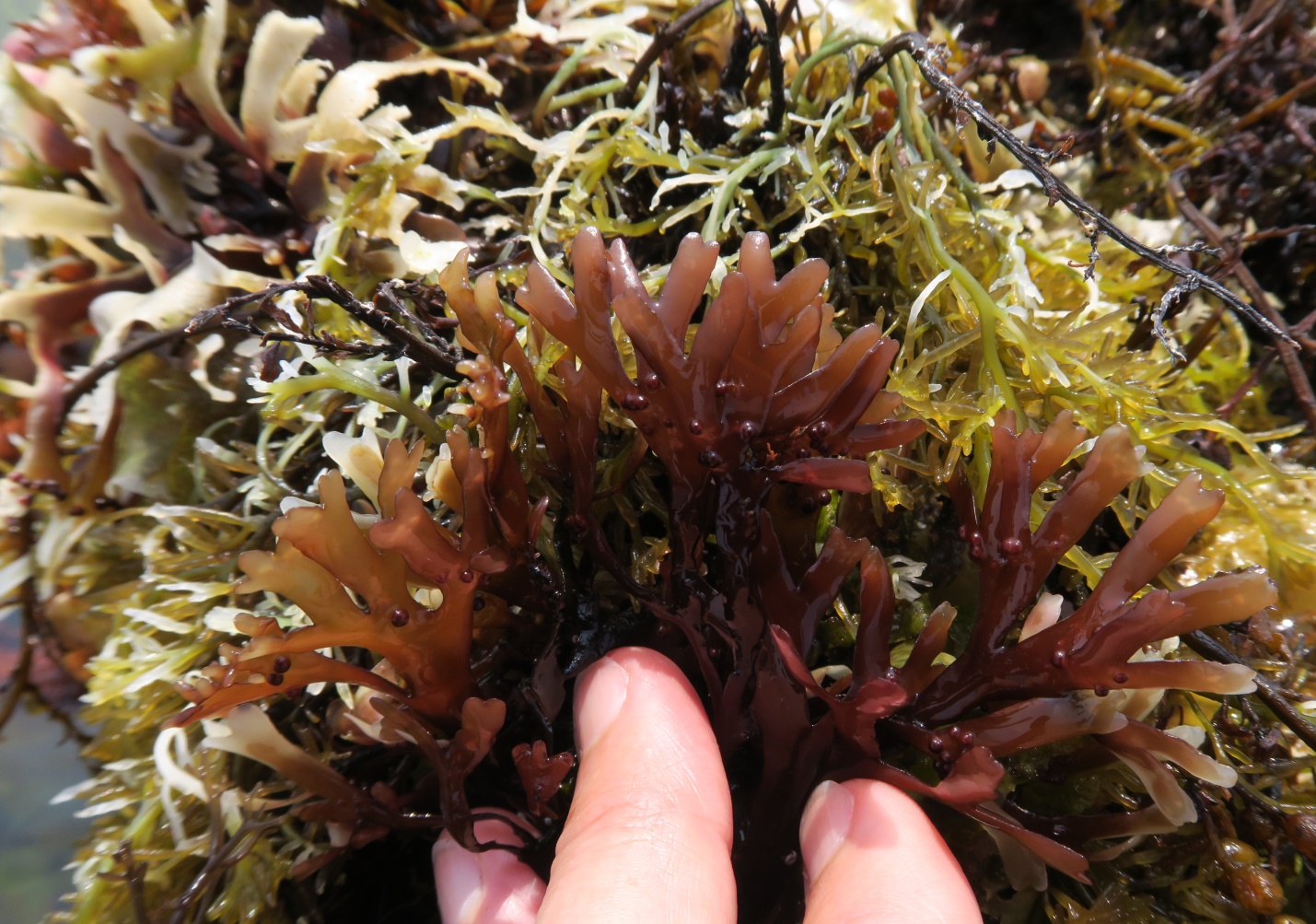
Figure 4: This is the underside of the same gametangial thallus viewed in Figure 3; you can see many conspicuous pustule like nemathecium sprinkled over the surface. Note that the underside of these lower thalli is more protected from sunlight and so there is less damage from sun bleaching. Point Holmes, Strait of Georgia, B.C., Canada. July 4, 2023. Photo ID 27574 ©Seaweedwhisperings.com
Discussion:
This seaweed expresses the epitome of confidence in staying with what works well – everything is ok AS IT IS! Almost every trait we’ve found in this Whispering fits with this concept. Sticking with the “tried and true” is Fredericqia chiton’s way of feeling confident and staying successful in the world.
Flattened...? This could be related to a largely two dimensional way of viewing the world. Two dimensional meaning that things are either: right or wrong, successful or unsuccessful. Three dimensional would indicate another level of exploration and this seaweed is clear that any further exploration is unnecessary, and even holds within inherent risks. There is, with exploring newly, the risk of finding out that there could be other ways of looking at things; their filter of right / wrong might be found to be “wrong” or even somewhat “less right” than previously believed, and that is very disquieting to them. This threatens the Fredericqia chiton way of being – and that way of being truly likes to be “fixed” firmly in place.
Person 1 found the forked branches of the thallus reminiscent of antennae. Consistent with the “watching out for threats to their way of being” concept just mentioned, these antennae were felt to serve the function of listening, and not for exploring in much any other way. And the motivation for the “listening”, well, it was primarily to be ready to defend, to protect against any possible threats to their way of being. Ironically sometimes that includes “not listening” to certain things; a type of “selective hearing” or a sorting FOR that which supports their world view and against that which does not.
This theme, right or wrong, could expand to color, too. Red is ‘right’ and healthy and vibrant, greenish and white is ‘wrong’, dying or degenerating.
There is a decided and fixed and rigid type of confidence to this energy. So while it is confident, there is a vulnerability to it, an internal weak spot. “I don’t want to go there” and/or “I’m not interested in discussing that” – these are two types of attitudes / statements that could be commonly expressed that indicate a strong preference with staying firmly or even stiffly as they are. And so the weak spot is that there is little confidence in exploring anything that is new or untested; there is basically not much room for change.
One consequence of consistently avoiding “the new” is that one becomes very particular about the niche that serves best. This seems to be the case for this seaweed, and it gives them a touch of the quality of a nobleman or aristocrat just in that they are quite uncommon, indeed, rather rare to encounter. Lack of flexibility or adaptability in survival needs and habitat requirements is a key biological factor related to population decline and even extinction of species – Fredericqia chiton seems to be playing on this edge with its way of being.
Orderly look – this seaweed had the most orderly and tidy look of all the various species in its locale. This reflects a high satisfaction with its own form – a kind of peak expression that needs no adjustments but only needs to be maintained and therefore also conserved as optimal. No more testing needs to be done, no new design ideas will be considered; the form is very fine, indeed, very fine just as it is.
Up front, clear and obvious. The wart-like reproductive prominences on the thalli really stand out. They are rounded and prominent - conspicuous. This is true of the look of the species as a whole and about its energy, too – as just mentioned above, it is notably tidy, orderly, and self-satisfied and this is obvious to the observer.
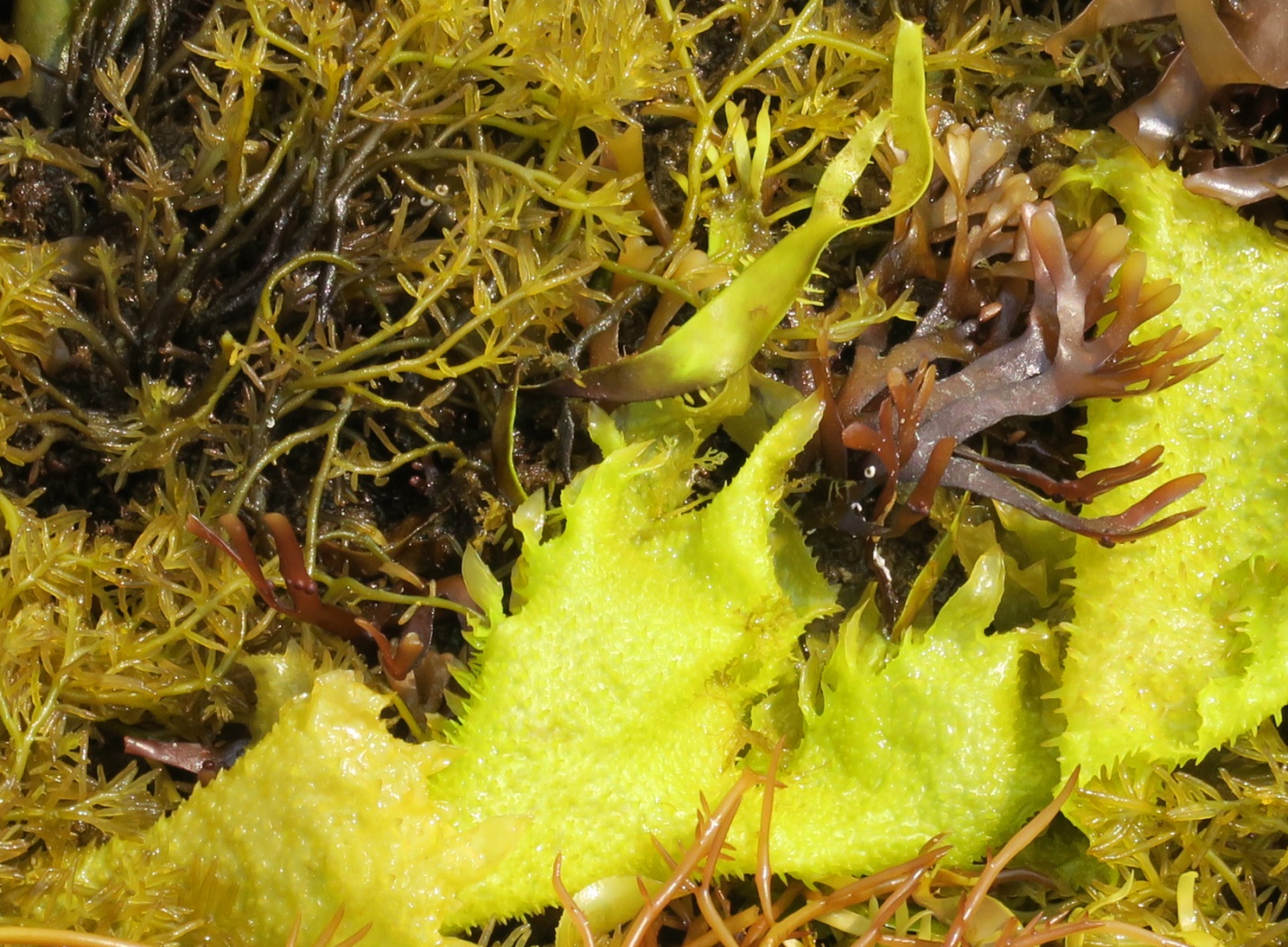
Figure 5: Situated as this individual is between some brightly bleached yellow-green Neogastroclonium subarticulatum and Prionitis sternbergii and Chondracanthus exasperatus ‘fronds’, the reddish brown thalli of Fredericqia chiton are exposed to view. Particularly on the right side of the photo you can see how “flattened” and “thin” the thalli truly are – features that lead to two of the common names for this species of “forked seaweed”. The tips of the forks are becoming bleached and discolored on this individual. Also scattered here and there on the thallus are conspicuous rounded and elevated wart-like protrusions called nemathecia – these are the sexual structures common to red algae. On this individual most of these are on the underside. Point Holmes, Strait of Georgia, B.C., Canada. July 4, 2023. Photo ID 27575 ©Seaweedwhisperings.com
Biology & Natural History Information:
Description:
Erect, stiff branches grow 8 to 15 cm tall; the dark-wine colored thallus has dichotomous branching, 4 – 6 mm wide at tip. Tips are robust and somewhat thick. At maturity the gametangial thallus, which is flat and broad, develops conspicuous pustule-like nemathecium on their surface. These nemathecium form rows of catenate tetrasporangia.
Habitat:
Moderately common on rocks at shallower depths within the kelp forest; often mixed with geniculate coralline algae. Low intertidal zone but mainly shallow subtidal and subtidal.
North Pacific Distribution:
The Pacific Coast of North America from British Columbia, Canada to Baja California, Mexico.
Remarks:
The similar red algae, Rhodymenia pacifica, grows flat rather than the more erect rosette of Fredericqia chiton, and the branch tips of F. chiton are much thicker. Other “forked seaweeds” such as Ahnfeltiopsis linearis are not so flattened or thin and broad in the thallus.
Classification:
Phylum: Rhodophyta
Class: Florideophyceae
Order: Gigartinales
Family: Phyllophoraceae
Genus: Fredericqia
Species: Fredericqia chiton (M.Howe) Maggs, L.Le Gall, Mineur, Provan & G.W. Saunders 2013
Former name(s):
Gymnogongrus chiton (M.Howe) P.C.Silva & DeCew 1979; Actinococcus chiton M.Howe 1914.
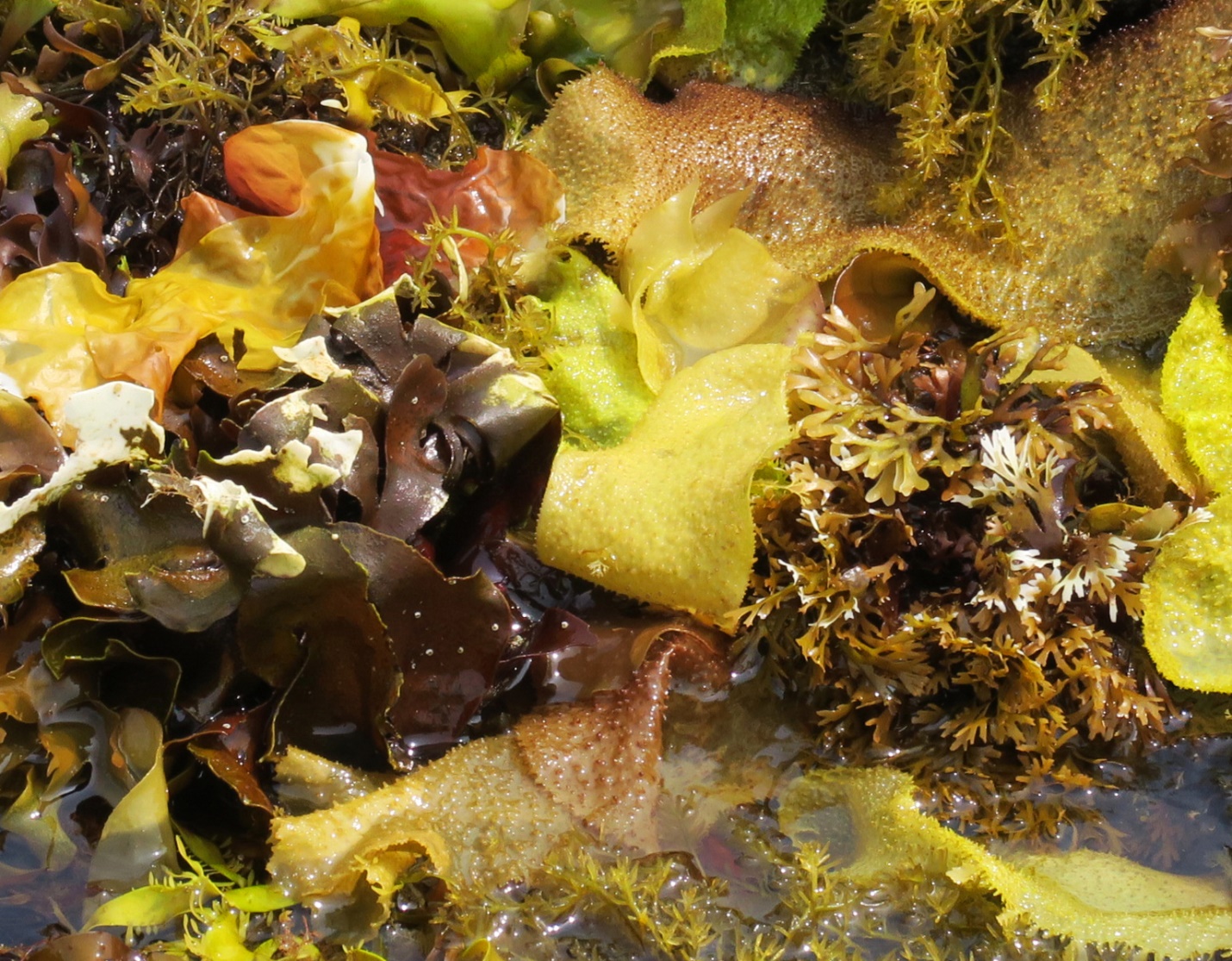
Figure 6: Mixed in with other macroalgae, Fredericqia chiton is suffering its own type of sun bleaching damage. The ‘rosettes’ or clusters of F. chiton on the right half of the photo are mainly olive greenish or white at the tips. The Constantinea, Prionitis, Chondrachanthus and Neogastroclonium algal species here are also faded to colors one would not immediately identify as true. Full summer, with its midday low tides and higher water temperatures, certainly has its impact in the intertidal zone. Point Holmes, Strait of Georgia, B.C., Canada. July 4, 2023. Photo ID 27576 ©Seaweedwhisperings.com
![]()